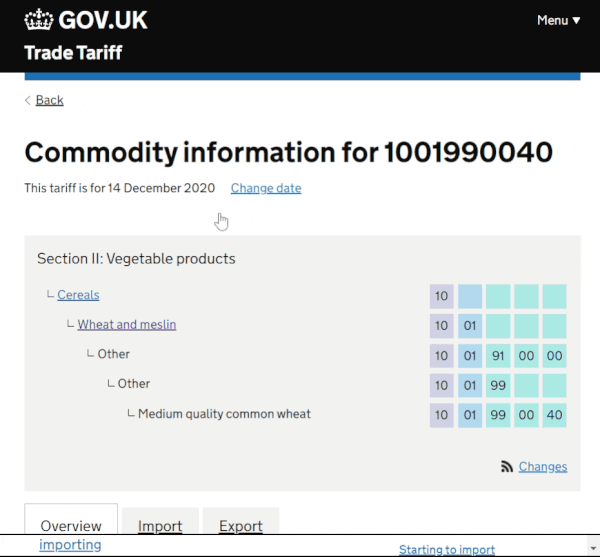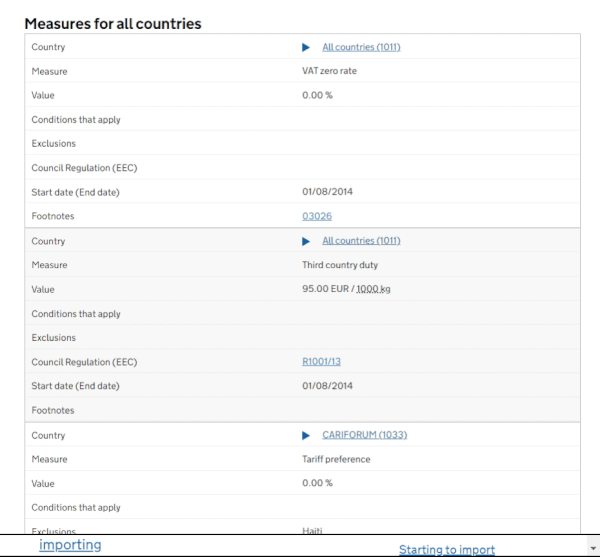How to check claims about tariffs and trade
Since the Brexit referendum in 2016, there’s been much more attention than usual on the UK and EU’s trade rules. One thing of particular interest has been the tariffs charged on imports from other countries.
At Full Fact we’ve seen many instances of misleading information based on misunderstanding trade and tariff data, which is understandable given how complex a lot of this information is.
From pro-Brexit commentators wrongly claiming that the EU puts high tariffs on African cocoa imports, to pro-Remain commentators claiming wrongly that the only reason the UK can sell lamb competitively to Japan is because of the EU-Japan trade deal, bad use of trade and tariff data can have real world effects.
From 2021, the UK will stop applying EU tariffs and apply its own to foreign imports. New arrangements mean the potential for confusion and misinformation is high.
Knowing which tariffs apply to imports is vital for businesses, and misinformation about tariffs can also be used to mislead the public.
This guide explains what tariffs are and how to research tariff rates.
Join 72,547 people who trust us to check the facts
Subscribe to get weekly updates on politics, immigration, health and more.
What are tariffs?
When businesses import or export goods and services from other countries they have to follow certain rules.
Part of these rules will be what tariffs to apply. Tariffs are essentially taxes on imports.
For example, from next year if you import cars from a country the UK doesn’t have a trade agreement with, you’ll have to pay about 10% of the value of the imported cars to HMRC.
Whether tariffs are a good or bad thing is open to debate.
Higher tariffs on imports mean that things cost more in the shops.
But by raising the price of foreign imports, tariffs help protect domestic producers.
For example, if a dairy farmer wants to buy farm vehicles from abroad they’ll have to pay more than if there wasn’t a tariff.
But tariffs on imported milk and cheese mean our UK dairy farmer doesn’t get undercut by cheaper foreign imports when they sell their products to UK consumers.
Why do tariffs vary by countries and what is a trade deal?
Typically countries have to set the same tariffs on imports from all foreign countries. The exception is when there is a trade deal between countries.
For example, countries in the EU are in a free trade area with each other. This means there are no tariffs on trade between EU countries.
The EU also has trade deals with other countries (such as Japan and Canada). This means tariffs on importing goods from these countries are reduced or removed.
Also, many countries reduce or remove tariffs on imports from developing countries. These arrangements usually just go in one direction, benefitting the developing countries.
How to look up a tariff?
For tariffs on goods coming into the UK, the best source is the information on gov.uk which is located here.
The first step is to choose which product you’re interested in importing or exporting. These can be incredibly specific (for example, the tariff on “high quality common wheat” is lower than the tariff on “medium quality common wheat”) so it’s important to pick the right one.

You can use the search bar and the links to navigate to the product of interest. There is some more guidance on choosing the specific product of interest here.
Then you’ll see three tabs labelled ‘overview’, ‘import’ and ‘export’.
If you click the ‘import’ tab you will then see a list of different charges applied to the product which can be incredibly long and confusing.

For example you’ll probably see a “third country duty” which says it applies to “all countries”. You might think this seems odd as, surely the UK doesn’t put tariffs on products coming from the EU at least?
In fact, that “all countries” is a false friend and doesn’t really represent what happens in practice (that businesses importing goods from countries the UK has a trade deal with may face a reduced tariff rate).
So before looking at that long list of charges, select the country you’re importing from to see the relevant charges.

Types of tariffs
There are various types of tariff which can apply to different goods.
Ad valorem tariffs (based on value)
One of the most common tariffs is simply a percentage tariff on the value of goods being imported, also called ad valorem tariffs.
For example, importing tanks from the USA (which doesn’t have a trade deal with the UK), faces a 1.7% tariff. So if the tank was imported for £100,000, you’d have to pay a £1,700 tariff as the importer.
This isn’t based on the eventual retail price of the product, just how much the importer has paid for it.
Specific tariffs (based on quantity)
Other tariffs are based not on the price of the goods being imported, but the physical amount or weight.
For example, importing butter from the USA faces a tariff of €189.60 per 100 kilograms. That’s applied regardless of the actual cost of the butter you’re importing. High-quality and low-quality butter face the same tariff based on weight (though in practice we import very little butter from outside the EU).
Compound tariffs
Some tariffs combine both a tariff based on value and a tariff based on weight.
For example, “high quality beef and veal” caracasses from the USA face a tariff of 12.8% of the purchase prices plus €176.80 per 100 kilograms.
(In some cases, parts of the tariff only apply to parts of the product. So with chocolate, part of the tariff applies to the sugar content).
Quotas
Additionally, for some goods, countries can set lower tariffs on a specific amount of product being imported than the usual rate. Once the amount of that product coming into the country has reached that quota, any future imports are charged the normal tariff, until the quota resets.
For example, the EU (whose tariff schedule the UK was following at the time of writing) allows around 45,000 tonnes of grain-fed beef to be imported from certain countries with a 0% tariff, and 67,000 tonnes of high-quality beef to be imported with a 20% tariff.
These replace the standard tariff of 12.8% plus €176.80 per 100kg.
Additional duties
Finally, one thing you might see is “additional duties”. For example, chocolate imports from the USA face a 25% tariff in addition to the regular tariff.
In this case this is because the EU has been authorised by the World Trade Organisation to place a number of extra tariffs on US imports in retaliation against illegal American state aid funding for Boeing.
Common pitfalls
Trade information is complex and there are common mistakes people make when interpreting the data.
One thing you might notice if you look through a few of the UK tariffs is that there appear to be very few export tariffs, if any.
You might think, then, that British goods don’t face tariffs when going to other countries.
There may not be tariffs applied by the UK government on the British exporter but there may well be tariffs applied by the foreign government on that country’s importing business.
But, in general, tariffs are paid by importers. There are very few export tariffs.
If you want to look up how much British goods may face in tariffs when exported abroad, you can use the World Trade Organisation’s data.
The EU’s database is also useful for looking up tariffs that the EU sets on imports.
Another issue is that sometimes multiple tariffs will show on the trade tables but not all of them apply.
So when you look up the tariffs on importing chocolate bars from France, that “third country duty” will disappear, which is correct because there are no tariffs on imports from the EU (at the time of writing).
But when you look up the tariff from South Africa, both a “third country duty” and a “tariff preference” are listed. But only the lower rate (the “tariff preference”) applies.
And finally, it’s always worth double checking your measurements.
Back in May, the Sun claimed that the EU put an £11.45 tariff on each half-litre of white wine imported from outside the EU.
It doesn’t take a check of the tariff tables as much as a check of a supermarket shelf to realise this was obviously wrong.
If the tariff on, say importing a half-litre of wine from South Africa was £11.45, then how could a customer buy a bottle of that wine for five or six pounds.
What the Sun had done was confuse the EU’s tariff per hectolitre (100 litres and abbreviated as “hl”) as its tariff per half-litre.
So while understanding trading and tariff rules is complex and often requires expert advice, there are some simple steps you can take to avoid believing some of the most common forms of misinformation in this area.